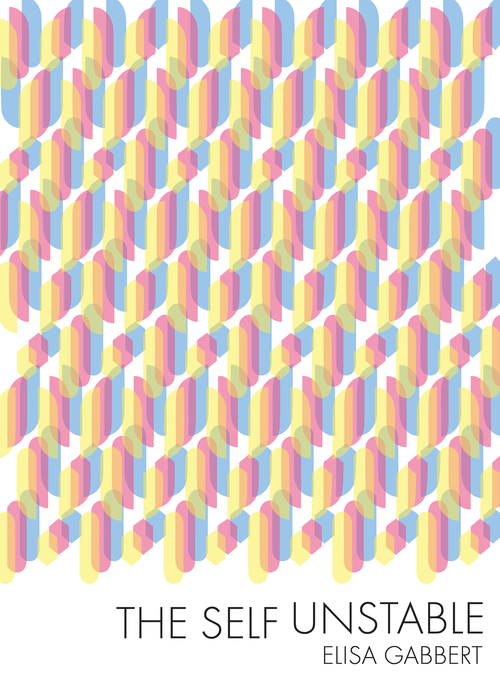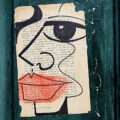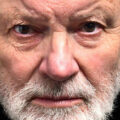404: Identity Not Found

The Self Unstable
by Elisa Gabbert
Softcover, $14.95
2013, Black Ocean
In March 2008, a month shy of his forty-fifth birthday, the critic and poet Reginald Shepherd was battling an aggressive form of colon cancer. The disease had already metastisized to his liver. He was in a tremendous amount of pain, with complications related to a series of other illnesses. As he underwent chemotherapy Shepherd wrote about his ordeal at the Poetry Foundation blog, Harriet:
Cancer came as a highly unpleasant surprise […] but psychologically it just confirmed my sense of my body as frail and vulnerable at best, or set on betraying me yet again at worst. I’ve never really identified with my body, have always seen it as distinct and separate from, even in opposition to, my “self.” It has felt more like a burden than anything else. Perhaps all these illnesses are my body’s revenge, its way of reminding me that I am it and it is mine, that it is me. What, after all, would I be without a body, however frail and ailing?
A few weeks later, the poet Linh Dinh juxtaposed this confession with Kenneth Goldmsith’s conceptualist assertion that “Now is the time of possibility we can be everyone and no one at all.” A person in pain, Dinh argued, could not possibly assent to the idea of an ultimately mutable self. Neither technology nor any poetic practice could actually disperse the stability at the center of lived experience. As Franz Kafka wrote, “people are sewn into their skins for life and cannot alter any of the seams.”
Displaying a typical largesse of intellect, Shepherd acknowledged in his response that “the most decentered self still has boundaries,” but wrote that “it is exactly the fact that I have other identities besides ‘a person with HIV’ or ‘a person with cancer’ that enable me to make it through my physical trials and travails.” The lack of stable identity was as a series of possibilities to be explored rather than a conflict to be resolved. Unfortunately, his illness placed boundaries before Shepherd that could not be overcome. By September of that year, he was gone.
Shepherd’s passing was an enormous blow to literary culture. It was far more significant, to be sure, for those who knew him. His death also sharpens this discussion about identity and stability, occurring as it did in the last year of his life, in the context of his illness. The absence of those who have died underscores the conflict between interior multiplicity and objective individuality. A living person, full of potential identities—poet, lover, gourmand, friend, son, etc.—is crystallized, finally, in the memory of those who survive, in the singular fact of their absence: that these manifold personae existed in one body, and as one person who cannot be recovered. The contradiction insists that one rendition of human identity—the unstable bundle of personae, or the single person lost forever—is a mirage.
In “What was the self?”—the preface to her acclaimed book, The Self Unstable—Elisa Gabbert reformulates this problem, “You wanted a life of causes, but it was all effects: you could never get before.” Like Dinh, she is posing a dilemma of will and object: how fluid is identity, can it be controlled, can it be understood? In sixty-seven brief lyric fragments, Gabbert explores the dynamics of shifting interiority through myriad identities (poet, daughter, sister, lover, wife) with a recognizable sardonic voice, stitched together with a complex set of themes and textual echoes. The underlying coherence is belied by the non-sequiturs, ironic humor, and associative logic of the texts. In the opening section of the book, “Transcending the Body: Memories, Dreams, Fears, & Fantasies,” she writes:
If luxury is obscene, all pleasures are obscene. The tyranny of matters of degree. Faux fur is cruel by way of reference to cruelty. In the moment, we value stability, but we prefer our painful memories. Happiness as intensity of experience. Don’t you always “feel the way you feel”?
Later in the collection, in the section titled “Enjoyment of Adversity: Love & Sex,” the question recurs in a different context:
My ex read about a woman who believed she was having orgasms, until she finally had a “real” one. He suggested my orgasms might not be real. What an odd way to undercut me, since he was the one providing them. Is it even possible to have an imaginary orgasm? If you believe you are happy, aren’t you, for all intents and purposes, happy? Don’t you always feel the way you feel?
By placing the first instance in quotations, Gabbert appears to be referencing her own future text (or her own future self). Is the painful memory of the first passage also drawing from the anecdote of the later one? How is pain destabilizing? What about the assertion that “all pleasures are obscene”? The non-linear patterning rewards second and third readings, and it places these fragments into multiple, overlapping, nearly simultaneous contexts. Unlike Maggie Nelson’s wonderful series, Bluets, which Gabbert has cited as an influence, each fragment here does not logically follow the last. Nor is the central focus in Gabbert’s collection as clear as it is in Nelson’s deconstruction of the word / color blue. The Self Unstable does not purport to argue, or make of the themes an edifice. It offers only loose associations, familiar gestures.
It would be natural for readers to assume that the title points toward postmodern deconstructions of the self, a lá Goldsmith. And there are shared concerns, particularly about technology, art, and media. But Gabbert’s text actually has closer ties to the thought of David Hume, the eighteenth century Scottish philosopher. Hume differentiated impressions (sensory input) from ideas, and argued that “the self” is not a real object, that it is no more than a linked bundle of perceptions. He believed that the existence of the self is inherently unstable, held together only by a trick of the imagination. In his Treatise on Human Nature (1739), Hume writes:
… [the] self or person is not any one impression, but that to which our several impressions and ideas are suppos’d to have a reference. If any impression gives rise to the idea of self, that impression must continue invariably the same, thro’ the whole course of our lives; since self is suppos’d to exist after that manner. But there is no impression constant and invariable. … The identity, which we ascribe to the mind of man, is only a fictitious one, and of a like kind with that which we ascribe to vegetables and animal bodies. It cannot, therefore, have a different origin, but must proceed from a like operation of the imagination upon like objects.
It’s striking, even today, how modern and radical this theory of the self seems. In the concluding fragment of The Self Unstable, Gabbert writes:
Koans are used to provoke “the great doubt.” Contentment isn’t happiness. I told a student that desire comes from boredom. But I seek desire, so why do I fear boredom? Maybe emotions are ideas. I believe in the end of history illusion, but I also believe in the end of history, the failure of all imagination. The future isn’t anywhere, so we can never get there. We can only disappear.
“The great doubt” is a Zen Buddhist concept that intends to lead to the unveiling of the (un)true nature of the self—though earlier she writes “I know nothing of Buddhism.” This is akin to the radical skepticism practiced by philosophers such as Hume and his more famous predecessor, Descartes. Blaise Pascal, the French philosopher who lived just prior to Hume, was an early interrogator of the relationship between boredom and desire. Boredom, he postulated, is fearful because it leads to self-degradation and sin. Hume categorized the emotions as impressions rather than ideas, and Gabbert directly questions the choice. The “end of history illusion” is a psychological phenomenon in which people acknowledge that they have changed but do not also believe that they will change. And for Hume, the imagination is what constructs the narrative between discreet impressions, creating a fictional sense of the stable self.
Gabbert’s text and Hume’s philosophy never come into direct argument. Instead, an intriguing dance of two discreet intellects is generated by a common melody. Think of the many dancers in Pharrell’s twenty-four hour video for his song, “Happy.” But by connecting Gabbert and Hume explicitly, powerful new associations emerge. “Don’t you always feel the way you fell?” for example, foregrounds the perceptive immediacy of lived experience that is the foundation of Hume’s work. There are many more.
Nearly all of the fragments in The Self Unstable are as densely packed as the selection above, but the collection is more than an elucidation of some philosophy. To judge the work as a treatise is to deny its artistry. As Gabbert writes, “Is art about anything? Whatever it is, it’s not meaning.” Somewhere there is a version of this essay in French, in which Gabbert’s fragments are called poème en prose. In that version, their fertile word-play, shifting tones, and vivid contexts are applauded to the exclusion of the intellectual meanings. Many of the works collected in The Self Unstable were published elsewhere as poems, and this genre instability compounds a central theme: that the text, and art, much like a human being, bends the artificial borders of identity. Take this fragment, from the second section of the collection:
I was bitten by a feral cat, who left her fang behind in my hand. My dream life has its own past, memories I only access when asleep. When something hurts in a dream, where do you feel the pain? Is there an analog in the real world? And likewise, for the beauty? If we can’t change the past, regret is a waste of time, but not worry or longing. Still, I prefer regret. If time is a vector, we are passengers facing the rear of the train.
Now compare it—both the stylistic elements and the playful logic—to Gabbert’s poem “L’Heure Blue,” which appears at the PEN web site:
I go to the movies, though I hate movies.
I always cry at the movies.
It seems important that imaginary people are happy.
No one asks why I never had children.
I guess never is a word for after
you’re dead, as in, “I never loved you.”
I imagine saying it at your grave.I imagine you with a grave, the way
I imagine having a daughter.She is always a daughter, never a son,
and never a baby, always 7 or 8.
I am my mother’s age.
Discursive, seemingly autobiographical, subtly sarcastic and matter-of-fact in tone, the poem shares key characteristics with The Self Unstable. It would be facile to ask whether line breaks are the only difference. The better questions is, What do her fragments do that marks them as lyric essays rather than prose poems? What do lyric essays do that set them apart from other genres? And by asking these questions, one opens the possibility that there is no significant distinction. In the landmark 1997 Seneca Review introduction to the lyric essay, Deborah Tall and John D’Agata describe the nascent form:
The lyric essay partakes of the poem in its density and shapeliness, its distillation of ideas and musicality of language. It partakes of the essay in its weight, in its overt desire to engage with facts, melding its allegiance to the actual with its passion for imaginative form. The lyric essay does not expound. It may merely mention. … It might move by association, leaping from one path of thought to another by way of imagery or connotation, advancing by juxtaposition or sidewinding poetic logic. Generally it is short, concise and punchy like a prose poem.
That second sentence is crucial to the argument, but also seems misleading. Perhaps it’s because poetical works are not by nature light, nor overtly disengaged with facts. Perhaps it’s because so many essays are light and do not deal strictly in facts—D’Agata himself has faced the latter challenge. Perhaps it is because, throughout the introduction, Tall and D’Agata use descriptions of poetry in order to define the genre. The lyric essay is, first and foremost, poetic. Their attempt to define the form fails to specify differences, and instead highlights the many characteristics that lyric essays share with poetry.
Likewise, no particular feature distinguishes Gabbert’s lyric fragments from prose poetry—a fact the author herself has acknowledged. They operate on the reader as poems do. They can be successfully measured by the rubrics of poetry. Their merits and limitations are those of poems. Would it not be better, then, to simply call these works by the name of prose poems? Wouldn’t it be better as well to call longer, more argumentative and logical lyric essays by their rightful name: essays? These older genres exert few, if any, formal limitations. The origin of the word essay was to trial, to test, to see what something is worth—that is, it already was a genre of experimentation; it is not suddenly in need of lyricization.
The genre of the lyric essay seems to exist primarily because the Anglophile tradition of prose poetry is so marginalized. In the space where Baudelaire and Rimbaud stand in the French tradition, English readers have placed Neitzsche and Benjamin. If not for that, there would have been no lyric essays but the world, if they tolerated the debate at all, would have called them simply poems.
Still, this work was published with intention, and the chosen genre ought not to be dismissed out of hand. There are technical elements of The Self Unstable that seem to identify these fragments as essays—the chapter groupings, the book-length sequence. But even these do so ironically, encouraging greater imaginative play and complexity, rather than logical organization. These technical elements can be explained as versions of “the play within the play.” One, however, ought not be overlooked too hastily—the most mechanical, essayistic, and dire of bibliographic elements: the index.
In a volume with only sixty-seven paragraphs of text, the index swells with 196 terms. Running like a spine at the back of the volume, a typical index intends to transform an unwieldy text (usually nonfiction, notable examples notwithstanding) into a handy, usable object. It lays major themes and key players bare, with each citation tallied like a box score. In Gabbert’s case, the entries range from banalities like Coca-Cola to intellectual jargon like Uncanny Valley.
Because of its context in this volume, however, the index carries substantial conceptual weight. Indices are the foundational structure of the computer age. Facebook, Amazon, Craigslist, OKcupid: all are little more than a series of indexed files and images. If the medium does have bearing upon the message, then what does the inclusion of the index signify here? The text provides some clues. Early in the collection, Gabbert makes an explicit link between the self, the internet, and the mode of communication:
Don’t just be yourself—build your personal brand. The self is unstable. It might not be found by the search engines. It might be rejected. The self regenerates every five or six days. A consistent brand, a coherent self. Consider the interface, testing for usability.
To simply exist is not enough; one must be verified, stabilized, by approved structures. Inserting a discrete enumeration of key terms in a volume of interrelated prose poems masquerading as lyric essays offers the visage of stability and access. Encountering the line, “When the novelty of the new wears off, it feels chintzy”, a reader might not recall the earlier connection, “In our pursuit of the new, we must cultivate fear, where there was no need for it historically.” But if they select the right term, the index will make connections for them: “Newness 39, 75”. In this way the interface reifies important themes by making them crucial to the embedded tool of referencing.
“Irony is seen as a filter on sincerity,” Gabbert writes, “in truth both irony and sincerity are filters. In its pure form the data is too powerful.” Maybe the power of the data generates instability. Perhaps the data exists not as a single object but as a bundle of datum in need of structure. The index then is a filter: for clarity, or stability. It acts in the same way as the imagination does in Hume. But even with this usable interface, significant meanings—related to fear, novelty, and taste, implied by a supple reading of the text itself—remain inaccessible without sustained engagement.
Borges famously imagined that a completely accurate map of any place would need to be exactly the same size, with all the same detail as the original. Since this is impossible, a real place becomes scaled, simplified, and seemingly accessible. Flaws are inherent. Along the same lines, an index acts as the map to a text, just as memory imperfectly maps out the past. “If life has any meaning,” Gabbert writes, “it comes at the end.” Is this because “Our lives are lived in the past”? Or is it because the living person defies boundaries and stability enough to refute any comprehensible meaning?
It may not be true that a person can be “everyone and no one at all,” but neither does it follow that a person’s boundaries—or what is contained within them—are stable enough to grasp. With its textual, formal, and genre instabilities, The Self Unstable offers a taste of vivid incomprehensibility. Each of the volume’s modes is a filter through which the reader accesses, incompletely, a sense of the self behind the work, and thus a sense of their own identity: “the self is universal, there is only one I—again, the thought arrives, but no longer seems profound.”
About Daniel Pritchard
Daniel E. Pritchard is the founding editor of The Critical Flame.





